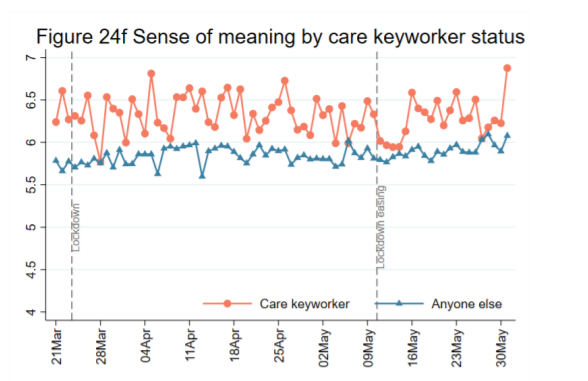What helped people and communities cope during Covid?
The first wave of Covid-19 caused huge suffering, and has led to warnings of an ‘epidemic’ or ‘tsunami’ of mental health problems. But there is another, more hopeful story to tell, about how people coped and even thrived during the adversity of 2020. It’s important to remember this as we head into the winter and a likely second wave.
The Collective Psychology Project has been researching how people coped, for a report for the Wellcome Trust called Collective Resilience. We were interested in how people discovered the ‘active ingredients’ of mental health, not just through therapy and pills, but also through self-care and mutual aid activities — from poetry to philosophy, from baking to cycling, from online learning to joining a neighbourhood support group.
What we discovered tallied with a lot of evidence, including from the Centre, about how people cope and thrive through non-medical activities like exercise, gardening, the arts, faith, philosophy and spirituality.
- Arts and creativity: from pop-up public art to TikTok dance trends, from pandemic poetry to a baking craze that drove the price of yeast up by more than 6,000%, people have found joy and meaning in the arts and creativity. UCL’s study of 70,000 adults’ mental health during the pandemic found that 22% engaged more with arts during the lockdown period than usual, and that engaging in creative activities — art, gardening, hobbies, reading fiction — was the single most helpful activity for people’s well-being.
- Family and relationships: in one survey, 25% of parents said the lockdown had brought them closer to their children, while only 5% said it had made relations worse. Young people were the worst hit by loneliness, but also the most connected online. And neighbourhoods became closer knit too: in the UK, 64% of adults felt that their communities had ‘come together to help each other’ during the crisis.
- Religion, philosophy and meaning-making: Google searches for prayer reached their highest ever level during the pandemic. Young people reconnected with their inherited faiths through a wave of online religious observance, and one in five Brits say they turned to psychology and philosophy to find meaning during the crisis. There have been sharp increases in the sales of Seneca’s Letters and Marcus Aurelius’ Meditations (itself written during a pandemic).
- Nature and green spaces: One survey suggested that 63% of people felt more connected to nature during lockdown; a boom in cycling has led to calls for the redesign of cities to make them more bike-friendly; seed shops sold out as people around the world started gardening; and the sudden improvement in emissions and air pollution globally have shown us what rapid cuts look and feel like. We rediscovered the importance of connecting to other species as well — although the spike in puppy sales raised concerns about impulse pet shopping. A majority of people don’t want the world to go back to how it was, and want green policies to be at the heart of recovery plans.
Post-traumatic growth
People had to develop new ways to say goodbye to loved ones at both the bedside and the graveside, while health workers and Covid patients have faced high levels of trauma. But there was also a renewed sense of meaning and transcendence among health workers: so-called ‘post-traumatic growth’. And the crisis has also created an opportunity for a fresh and more holistic approach to trauma treatments (like, say, whole-person approaches using the arts, nature, spirituality or psychedelic therapy).

What conclusions can we draw from this?
Here are some suggestions and reflections:
- Doctors and health authorities should be careful not to pathologise the normal and appropriate suffering people feel in hard times, or to immediately prescribe pills for emotional suffering. Anti-depressants can be helpful in the short-term, but they also have side effects and can lead to long-term dependency. Declaring a mental health ‘epidemic’ and saying mental health services are the only solution can create bottlenecks for services that either don’t exist or have long waiting lists.
- As well as supporting mental health services, we can also emphasise people’s strengths, assets and natural coping skills, including community approaches like getting to know your neighbours or joining local mutual aid groups. This empowers people rather than making them feel weaker and more dependent on medical experts.
- Build psychological flexibility, rather than happiness. Policy makers have tried to improve people’s happiness in schools, companies and society. There is some evidence this is counter-productive, especially in difficult times. It can make people ashamed of feeling anxiety, anger or grief, even if these emotions are appropriate. Instead of focusing narrowly on happiness, we can help people develop psychological flexibility, and discover what gives them a sense of meaning and purpose, especially in adversity. This could make people more resilient and less prone to ‘the happiness trap’ (ie avoiding activities that make them feel anxious in the short-term).
- Wellbeing involves all aspects of society, from the economy to the arts to travel and green spaces. Building a thriving organisation or society means taking a joined-up approach. That joined-up approach needs to come from the top — from the head of state, or the CEO of an organisation, or the head of a school or university.
- We need community infrastructure for communities to thrive — shutting down theatres, churches, youth groups, sports facilities and pubs. Yes, online courses have boomed, but we can’t go entirely digital, nor should governments only support big national arts projects. We all need to support local organisations that foster well-being, especially local companies.
What does a wellbeing-informed recovery look like?
Sign up for our eight week email series on how you can develop a Covid recovery plan that supports everyone. It shows the different impacts for different groups in society, as well as the wellbeing implications, and measures and resources you can start using right away.
